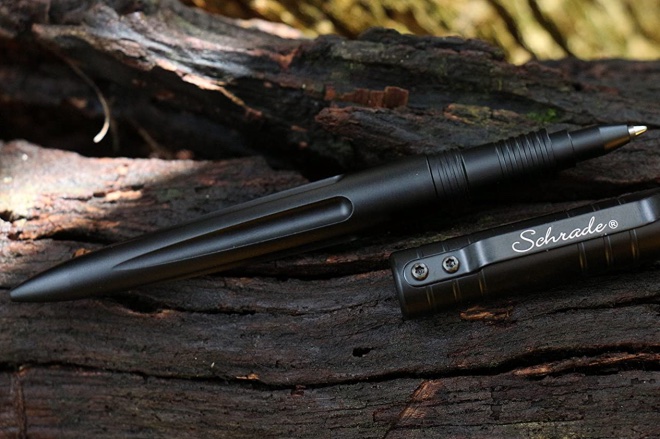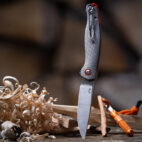Best Tactical Pens to EDC
When it comes to everyday carry, having the right tools to get you out of of a pinch is part of the appeal. And then having a tool that can pull ‘double duty’, or even multiple useful things, is even better when you’re weighing up what wins a place in your daily setup. Enter the best tactical pens of 2021. They write when you need to scribble down ideas, phone numbers or sketch, but they’re more than that. They can also be a bit of a lifesaver.
What’s a Tactical Pen?
Simply put, a tactical pen is a writing instrument that can also be used in self-defence or in an emergency to break through a barrier, like glass. They’re built with extra-sharp ballpoints, a strong blunt end to break barriers, and are made strong, in machined steel, aircraft-grade aluminium or titanium and other metals.
What to Look in a Tactical Pen?
With so many custom and mainstream makers producing tactical pens, it’s really hard to tell them apart when choosing the right pen for you. There are three things that make up a good tactical pen.
Writes Well
First and foremost, a tactical pen must write well. 99.9% of the time, this will be the function of the pen so it should excel at this. Look for pens with a high quality and well known refill. Extra points for ones that use pressurized refills, like those from Fisher, so the pen works in any environment or situation. The pen mechanism should also be one that you are comfortable with but does not get in the way of the grip when using it to defend or break barriers in emergency. For example, side-mounted bolt action retractors are usually a better choice than a traditional top push-button because it minimizes the chances of a false deployment.
Strong barrel with good handhold
Tactical pens are modeled after Kuboton sticks which were developed by Takayuki Kubota, as a modernized version of Yawara sticks carried by Buddhist monks for self-defense.
With this in mind, a good tactical pen must be able to be used as a kubuton. This means the pen must be large enough for the user to get a good grip on it. Knurling or texture on the body of the pen can aid you, as well as a good length and weight. A so-called “icepick” grip is common for kubotons and this differs from how one would hold a pen for writing, so take that into consideration.
Lastly, the pen must have a striking point. For most tactical pens, this would be the end of the pen where the ink flows. Some pens also have a strong, blunt end at the back for barriers.
Quality Construction
A good tactical pen must be built of quality materials so it doesn’t fail during use. Look for pens made of high grade aluminum or titanium. Avoid plastic pens if possible. As mentioned earlier, a knurled grip will make it easier to hold. Also look for an attachment clip as a way to keep it close by on your body. If it’s easy to carry with you, you’ll likely take it along.
With that said, let’s take a look at the best tactical pens on offer.
Gerber Impromptu

A real fan favorite and mainstay of the tactical pen category, the Gerber Impromptu checks all the boxes. It’s made of a machined steel body coated in Cerakote for a matte and durable finish. It measures 5.59 inches and weighs 2 oz for the right balance of weight but is out of mind when in your pocket. A stainless steel pocket is durable and keeps the Impromptu handy. It uses a “Rite in the Rain” ink cartridge which, as the name implies, works in all types of inclement weather. And perhaps most uniquely, it has an integrated glass-breaker tip made of tempered steel, that’s always exposed next to the pen tip. To use it, just make sure the cartridge isn’t deployed and strike firmly at the window.
Nitecore NTP31 Tactical Pen

Nitecore’s entry in the tactical pen arena is perhaps one of the most subdued and conservative approaches yet it still packs a punch. The NTP31’s body is made of aluminum alloy by the bezel is tungsten steel which is revered for it’s hardness, perfect for glass breaking. It measures 5.2 inches long and weights just 0.72 oz and with a body diameter of 0.4 inches, it’s one of the smallest pens on the list. The unique three position bolt mechanism deploys the replaceable Schneider gel ink refill on the pen side and the tungsten tip on the opposite end. The lightweight stainless steel clip keeps the pen low in the pocket, to avoid attention while the subdued shape does the same.
Boker Plus MPP Grey Tactical Pen

The MPP Grey measures 5.91 inches and weights 1.4 oz which makes it on the larger side of pens in this roundup. The versatile pen is made of aluminum and has wide grooves in the body, making it comfortable to hold. The writing side of things is covered by a pressurized Fisher Space-Pen refill and an interesting design element is Boker used a left-hand thread to swap refills; this is to prevent it coming loose when the screw cap is removed. Speaking of cap, it includes a beefy pocket clip and the end has an exposed glass breaker. Both that end and the opposite can be used for Kubotan techniques.
CountyComm Brass Embassy Pen

Having gone through multiple iterations, the County Comm Embassy is largely the same Made In The U.S.A. self-defense pen that has proven a customer favorite for years. The Revision 4 is available in a limited edition brass finish and is upgraded with an enhanced smooth top band knurl for a better grip. It measures 5.25 inches with a 0.5-inch diameter and it weighs 4 oz, putting it on the heavier side of the pens on the list. This is due to the material choice which is C630 Free Machining Brass. This pen most closely resembles a kuboton due to its diameter and rounded ends, on both sides. Like the Schrade below, the Embassy Pen unscrews to expose the writing tip, this time powered by medium SPR4 pressurized Fisher Space Pen refill. Rounding out this near-perfect package is the stainless steel clip that is stonewashed finished.
Hinderer Investigator Defense Tactical Pen

Perhaps the only pen on the list that is designed and machined by a knife-making legend, the Hinderer Investigator is a more easily carried alternative to the Extreme Duty pen. Shallow grooves run along the length of the center of the body while deeper grooves are cut perpendicular near both ends. It’s a smaller pen measuring 4.25 inches you can choose among materials from titanium, copper, brass, etc. Speaking of customizability, it uniquely features a modular design so the customer can attach different ends to the pen. Finally, it uses a Fisher Space pen refill.
RovyVon Commander C20 Titanium Tactical Pen

The first titanium pen on our lists is a beauty and it comes from keychain flashlight wonder-brand RovyVon. The C20 is precision CNC machined out of TC4 titanium alloy, allowing the 5.03-inch pen to weigh just 0.945 oz. It sits comfortably in the middle of the pack with its 0.38-inch diameter body. Speaking of the body, it features fine grooves cut in the lower half for a better grip. Besides the body material, the top end of the pen might be the most interesting part. To use the ceramic ball glass breaker, you have to first twist the top to lock it in. The top also had three tritium slots for a chance to customize your pen and for easier spotting at night.
Smith & Wesson M&P 2nd Generation Tactical Pen

Often referred to by the SKU number, Smith & Wesson tactical pens make up for what they lack in memorable names, with features. Measuring 5.8 inches and weighing 1.4 oz, this is one of the larger and heavier pens in our roundup. Made of aircraft aluminum and, a narrow pocket clip, and a screw-off cap, the 2nd generation has perhaps the most practical shape of the S&W lineup. There are wide grooves machined into the side of the body, reminiscent of a bamboo pen design, which makes gripping it easy. The top of the pen is wide and flat, making it an ideal thumb resting spot while striking. As previously mentioned, to get to the pen portion, you unscrew the top, which means that when the pen isn’t exposed, you always have access to the striking end. S&W decided to go for a broader tip rather than a pointy one. It uses a popular Schmidt P900M Parker Style refill.
CRKT Williams Defense Pen

CRKT reached out to former Army officer and martial arts instructor James William, to help them develop the Defense Pen. The body is made of aluminum which combines lightweight carry with strength. The body is bead blasted to minimize reflection, for true stealth carry. And, it sports a pressurized ink cartridge for writing in any condition. The pen measures 6 inches and weighs 1.30 oz. Broad grooves on both ends makes it easy to grip and like the Smith & Wesson, uses a capped design with a pointy striking end always exposed.
Schrade SCPENBK Tactical Pen

Rounding out this list is one of the more affordable and simple-looking pens. This pen from Schrade is the only model with a screw-off cap. This means that the pen’s default state is as a protection tool and it takes an extra bit of effort to expose the writing tip. Speaking of writing, it uses a Schmidt P900 Parker Style which are great to write with and are easy to find refills for. The pen measures 5.7 inches and weighs 1.4 oz. It’s made of CNC Machined T6 aluminum and features long teardrop grooves in the main body, tapering to a pointy but still somewhat broad striking tip. The pocket clip sits high on the pen to help clear your hand and is removable. Lastly, the end opposite of the pointy side, is flat, which allows you to rest your thumb to rest on top in a modified ice pick grip.
Editor’s note: If you’re keen to try a tactical pen, we recommend self-defence training to really make sure you can use these pens properly when you need to, so make sure that’s something you do right away. Also, depending on where you reside and what situation you’re in (ie: airports) these pens can be considered weapons, so make sure you do your due diligence before pocketing one of these pens and heading out the door.





 Carry Awards
Carry Awards Insights
Insights Liking
Liking Projects
Projects Interviews
Interviews













One thought on “Best Tactical Pens to EDC”
Comments are closed.